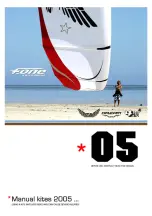
_
57
_
EN
_
56
Tow launch
When towing, the AONIC displays no peculiarities. Please note that it
is important to climb away from the ground at a shallow angle.
We recommend the use of a tow adapter. This adapter is connected to
the main carabiners and links them with the tow release.
Normal flight
The AONIC has its best glide performance at trim speed, i.e. when the
brakes are fully released. In calm air, the wing will travel the greatest
distance over a given height.
With headwind or a sinking airmass, maximum glide can be achieved
by using the speed system. During accelerated flight in turbulent air,
attention should be paid to the dynamic reaction of the wing in case of
a collapse. Lots of height above the ground is advisable.
In strong turbulence it is advisable to gently pull both brakes to increa-
se stability. The brakes provide feedback about the surrounding air,
which is needed for active flying.
By active flying we mean the constant control and correction of the
angle of attack in turbulent air. For example, if a pilot flies from an area
of lift to an area of sink, if there is no pilot input, the angle of attack will
be reduced and the wing will pitch forward. Reduced brake pressure
will indicate the start of this pitch movement to the pilot.
The correct reaction is to increase the brake input to prevent the
forward pitch.
Some of the required techniques can be practised during ground hand-
ling, for example, by attempting to keep the wing flying above your
head without looking at it. This exercise is also useful for successful
forward launches.
Accelerated flight
Fitting the speed system
The majority of harnesses are fitted with two pulleys per side. Some
(lightweight) harnesses instead have two simple rings or loops. The
two speed bar cords are pulled from top to bottom through both
pulleys/rings and fitted to the foot bar.
Overall, the launch
behaviour is very
simple. The wing
forgives errors. No
special skills are
needed to launch
the wing.
Cases of an
escalation of a
collapse can be
prevented by
active flying.
Colour-coded for additional safety
In general aviation green represents right and red represents left. We
have used this colour scheme in our paragliders: the hang points on
the right are green, on the left they are red. Additionally, the risers are
marked »L« and »R«. This should assist you in your pre-flight prepa-
ration and helps to avoid attaching the glider incorrectly – especially
when reverse launching.
Take off
General
The pilot has the responsibility to check that their entire equipment is
in full working order. In particular, the wing, harness and the parachute.
Immediately before launch we recommend the following pre-flight
check, which should be conscientiously performed before every take
off. Sadly, many launch accidents result from an omitted pre-flight
check.
1. Buckled-up:
leg and chest straps are connected, chin strap on the
helmet is closed
2. Clipped-in:
risers are not twisted, speed system is correctly connected,
carabiners are locked
3. Lines:
A-lines are on top, all lines are sorted and free of knots, brake
lines run cleanly through the pulleys
4. Canopy:
wing is laid out on launch in an arc with leading edge open
5. Wind and air space:
wind is suitable for take off, air space is clear
The AONIC distinguishes itself by its easy inflation behaviour (both
during forward and reverse launch) and without wanting to hang back.
The wing climbs cleanly and directly without a tendency to overshoot.
Confident launches can only be learnt by practise – there is only a
limited knowledge to be gained from books and descriptions. So here
is a tip: Use every opportunity on a training hill to perfect your launch
technique. Ideally, have an experienced colleague or instructor with
you to provide feedback.
!
Right is green, left
is red – this colour
scheme helps you to
avoid clipping your
wing to your harness
incorrectly.
!
Summary of Contents for AONIC
Page 1: ...Manual _DE _EN ...













































